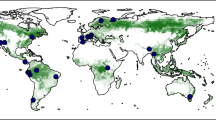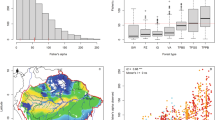Abstract
The global extent and distribution of forest trees is central to our understanding of the terrestrial biosphere. We provide the first spatially continuous map of forest tree density at a global scale. This map reveals that the global number of trees is approximately 3.04 trillion, an order of magnitude higher than the previous estimate. Of these trees, approximately 1.30 trillion exist in tropical and subtropical forests, with 0.74 trillion in boreal regions and 0.66 trillion in temperate regions. Biome-level trends in tree density demonstrate the importance of climate and topography in controlling local tree densities at finer scales, as well as the overwhelming effect of humans across most of the world. Based on our projected tree densities, we estimate that over 15 billion trees are cut down each year, and the global number of trees has fallen by approximately 46% since the start of human civilization.
This is a preview of subscription content, access via your institution
Access options
Subscribe to this journal
Receive 51 print issues and online access
$199.00 per year
only $3.90 per issue
Buy this article
- Purchase on Springer Link
- Instant access to full article PDF
Prices may be subject to local taxes which are calculated during checkout





Similar content being viewed by others
Change history
09 September 2015
Minor changes were made to the Author Contributions statements.
13 April 2016
The link for the global tree density map was added to the Author Information section.
References
Pan, Y. et al. A large and persistent carbon sink in the world’s forests. Science 333, 988–993 (2011)
Crowther, T. W. et al. Predicting the responsiveness of soil biodiversity to deforestation: a cross-biome study. Glob. Change Biol. 20, 2983–2994 (2014)
Hansen, M. C. et al. High-resolution global maps of 21st-century forest cover change. Science 342, 850–853 (2013)
Bonan, G. B. Forests and climate change: forcings, feedbacks, and the climate benefits of forests. Science 320, 1444–1449 (2008)
Pfeifer, M., Disney, M., Quaife, T. & Marchant, R. Terrestrial ecosystems from space: a review of earth observation products for macroecology applications. Glob. Ecol. Biogeogr. 21, 603–624 (2012)
Tuanmu, M.-N. & Jetz, W. A global 1-km consensus land-cover product for biodiversity and ecosystem modelling. Glob. Ecol. Biogeogr. 23, 1031–1045 (2014)
Walker, A. P. et al. Predicting long‐term carbon sequestration in response to CO2 enrichment: how and why do current ecosystem models differ? Glob. Biogeochem. Cycles 29, 476–495 (2015)
Asner, G. P. et al. A universal airborne LiDAR approach for tropical forest carbon mapping. Oecologia 168, 1147–1160 (2012)
Fauset, S. et al. Hyperdominance in Amazonian forest carbon cycling. Nature Commun. 6, 6857 (2015)
Slik, J. W. F. et al. Environmental correlates of tree biomass, basal area, wood specific gravity and stem density gradients in Borneo’s tropical forests. Glob. Ecol. Biogeogr. 19, 50–60 (2010)
Leathwick, L. R. & Austin, M. P. Competitive interactions between tree species in New Zealand old-growth indigenous forests. Ecology 82, 2560–2573 (2001)
Oliver, C. D. & Larson, B. C. Forest Stand Dynamics (John Wiley & Sons, 1996)
Riginos, C. & Grace, J. B. Savanna tree density, herbivores, and the herbaceous community: bottom-up vs. top-down effects. Ecology 89, 2228–2238 (2008)
O’Neil-Dunne, J., MacFaden, S. & Royar, A. A versatile, production-oriented approach to high-resolution tree-canopy mapping in urban and suburban landscapes using GEOBIA and data fusion. Remote Sens. 6, 12837–12865 (2014)
Guldin, R. W. Forest science and forest policy in the Americas: building bridges to a sustainable future. For. Policy Econ. 5, 329–337 (2003)
Cao, S. et al. Greening China naturally. Ambio 40, 828–831 (2011)
Oldfield, E. E. et al. Growing the urban forest: tree performance in response to biotic and abiotic land management. Restoration Ecol. (http://dx.doi.org/10.1111/rec.12230) (2015)
Nadkarni, N. Between Earth and Sky: Our Intimate Connections to Trees (Univ. of California Press, 2008)
ter Steege, H. et al. Hyperdominance in the Amazonian tree flora. Science 342, 1243092 (2013)
Bonan, G. B. & Shugart, H. H. Environmental factors and ecological processes in boreal forests. Annu. Rev. Ecol. Syst. 20, 1–28 (1989)
Meyfroidt, P. & Lambin, E. F. Global forest transition: prospects for an end to deforestation. Annu. Rev. Environ. Resour. 36, 343–371 (2011)
Rudel, T. K. The national determinants of deforestation in sub-Saharan Africa. Phil. Trans. R. Soc. Lond. B 368, 20120405 (2013)
Hengeveld, G. M. et al. A forest management map of European forests. Ecol. Soc. 17, 53 (2012)
Kindermann, G. E., McCallum, I., Fritz, S. & Obersteiner, M. A global forest growing stock, biomass and carbon map based on FAO statistics. Silva Fennica 42, 387–396 (2008)
Stephenson, N. L. et al. Rate of tree carbon accumulation increases continuously with tree size. Nature 507, 90–93 (2014)
Zhu, K., Woodall, C. W., Ghosh, S., Gelfand, A. E. & Clark, J. S. Dual impacts of climate change: forest migration and turnover through life history. Glob. Change Biol. 20, 251–264 (2014)
Lewis, S. L. et al. Above-ground biomass and structure of 260 African tropical forests. Phil. Trans. R. Soc. Lond. B 368, 20120295 (2013)
Brus, D. J. et al. Statistical mapping of tree species over Europe. Eur. J. For. Res. 131, 145–157 (2011)
USDA Forest Service. Forest Inventory and Analysis National Program http://fia.fs.fed.us/ (2010)
Steinwand, R. S., Hutchinson, J. A. & Snyder, J. P. Map projections for global and continental data sets and an analysis of pixel distortion caused by reprojection. Photogramm. Eng. Remote Sensing 61, 1487–1499 (1995)
Chavent, M., Kuentz, V., Liquet, B. & Saracco, J. ClustOfVar: an R package for the clustering of variables. J. Stat. Softw. 50, 1–16, http://www.jstatsoft.org/v50/i13/ (2012)
Bartoń, K. MuMIn: Model selection and model averaging based on information criteria (AICc and alike). (https://cran.r-project.org/web/packages/MuMIn/index.html) (2015)
MacKenzie, D. I. et al. Occupancy Estimation and Modeling (Academic Press, 2005)
MacLean, M. G. et al. Requirements for labelling forest polygons in an object-based image analysis classification. Int. J. Remote Sens. 34, 2531–2547 (2013)
Ståhl, G. et al. Model-based inference for biomass estimation in a LiDAR sample survey in Hedmark County, Norway. Can. J. For. Res. 41, 96–107 (2011)
Tuanmu, M.-N. & Jetz, W. A global, remote sensing-based characterization of terrestrial habitat heterogeneity for biodiversity and ecosystem modelling. Glob. Ecol. Biogeogr. http://dx.doi.org/10.1111/geb.12365 (2015)
Acknowledgements
We thank P. Peterkins for her support throughout the study. We also thank Plant for the Planet for initial discussions and for collaboration during the study. The main project was funded by grants to T.W.C. from the Yale Climate and Energy Institute and the British Ecological Society. We acknowledge various sources for tree density measurements and estimates: the Canadian National Forest Inventory (https://nfi.nfis.org/index.php), the US Department of Agriculture Forest Service for their National Forest Inventory and Analysis (http://fia.fs.fed.us/), the Taiwan Forestry Bureau (which provided the National Vegetation Database of Taiwan), the DFG (German Research Foundation), BMBF (Federal Ministry of Education and Science of Germany), the Floristic and Forest Inventory of Santa Catarina (IFFSC), the National Vegetation Database of South Africa, and the Chilean research grants FONDECYT no. 1151495. For Europe NFI plot data were brought together with input from J. Rondeux and M. Waterinckx, Belgium, T. Bélouard, France, H. Polley, Germany, W. Daamen and H. Schoonderwoerd, Netherlands, S. Tomter, Norway, J. Villanueva and A. Trasobares, Spain, G. Kempe, Sweden. New Zealand Natural Forest plot data were collected by the LUCAS programme for the Ministry for the Environment (New Zealand) and sourced from the National Vegetation Survey Databank (New Zealand) (http://nvs.landcareresearch.co.nz). We also acknowledge the BCI forest dynamics research project, which was funded by National Science Foundation grants to S. P. Hubbell, support from the Center for Tropical Forest Science, the Smithsonian Tropical Research Institute, the John D. and Catherine T. MacArthur Foundation, the Mellon Foundation, the Small World Institute Fund, numerous private individuals, the Ucross High Plains Stewardship Initiative, and the hard work of hundreds of people from 51 countries over the past two decades. The plot project is part of the Center for Tropical Forest Science, a global network of large-scale demographic tree plots.
Author information
Authors and Affiliations
Contributions
The study was conceived by T.W.C and G.H. and designed by T.W.C., K.R.C. and M.A.B. Statistical analyses were conducted by H.B.G., S.M.T., J.R.S., C.B., D.S.M. and T.W.C. and mapping was conducted by H.B.G. and C.B. The manuscript was written by T.W.C. with input from M.A.B., P.C., D.S.M., H.B.G. and C.B., with comments provided by all other authors. Tree density measurements or geospatial data from all over the world were contributed by K.R.C., S.M.T., M.C.D., G.A., M.N.T., W.J., C.Sa., C.St., D.P., T.T., S.G., G.B., S.J.W., S.K.W., M.O.H., G.M.H., G.J.N., E.T., P.B., C.F.L., L.W.P.,M.F., A.H., J.H., P.C., A.C.V., P.M.U., S.L.P., C.W.R. and M.S.A.
Corresponding author
Ethics declarations
Competing interests
The authors declare no competing financial interests.
Additional information
The global tree density map can be found at http://elischolar.library.yale.edu/yale_fes_data/1/.
Extended data figures and tables
Extended Data Figure 1 Histogram of the collected measurements of forest tree density in each biome around the world (n = 429,775).
The red line and the blue dotted lines indicate the mean and median for the collected data, respectively. Data in each biome fitted a negative binomial error structure.
Extended Data Figure 2 Histogram of the predicted forest tree density values for the locations that density measurements were collected in each biome around the world (n = 429,775).
The red line and the blue dotted lines indicate the mean and median for the collected data, respectively. As our models were based on mean values, the majority of points fall on or close to the mean values in each biome.
Extended Data Figure 3 Histogram of the total predicted forest tree density values for each pixel within each biome around the world (n = 429,775).
This illustrates the spread of pixels throughout each biome, and highlights that our map accounts for the sampling bias in tree density plots (for example, although we had no zero values in our desert plots, the vast majority of desert pixels contain no trees).
Extended Data Figure 4 Comparison between approaches to generate the global tree density map.
The initial map was generated using 14 biome-level models (biomes delineated by The Nature Conservancy http://www.nature.org) to account for broad-scale variations in terrestrial vegetation types. With several thousand plot-level density measurements in most biomes, this approach provided highly accurate estimates at the global scale. However, to improve precision at the local scale, we also generated a map using ecoregion-scale models. Separate models were generated within each of 813 global ecoregions (also delineated by The Nature Conservancy to reflect smaller-scale vegetation types) using exactly the same statistical approach (see Methods). The same 429,775 data points were used to construct each map. Biome-level and ecoregion-level maps provide total tree estimates of 3.041 and 3.253 trillion trees, respectively.
Supplementary information
Supplementary Table 1
Summary Table showing the number of plot estimates and total tree numbers (with 95% confidence interval) at the biome and global scale. (XLSX 15 kb)
Supplementary Table 2
This table shows the number of trees and tree densities for countries of the world, as estimated using 2 independent approaches (biome and ecoregion-level models) and the database of Global Administrative Areas, version 2.7 (http://gadm.org/). (XLSX 53 kb)
Rights and permissions
About this article
Cite this article
Crowther, T., Glick, H., Covey, K. et al. Mapping tree density at a global scale. Nature 525, 201–205 (2015). https://doi.org/10.1038/nature14967
Received:
Accepted:
Published:
Issue Date:
DOI: https://doi.org/10.1038/nature14967
This article is cited by
-
Global spatial assessment of potential for new peri-urban forests to combat climate change
Nature Cities (2024)
-
Farm forests, seasonal hunger, and biomass poverty: Evidence of induced intensification from panel data in the Ethiopian Highlands
Ambio (2024)
-
Consistent patterns of common species across tropical tree communities
Nature (2024)
-
Reassessment of growth-climate relations indicates the potential for decline across Eurasian boreal larch forests
Nature Communications (2023)
-
Turning dead leaves into an active multifunctional material as evaporator, photocatalyst, and bioplastic
Nature Communications (2023)
Comments
By submitting a comment you agree to abide by our Terms and Community Guidelines. If you find something abusive or that does not comply with our terms or guidelines please flag it as inappropriate.



